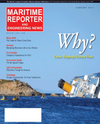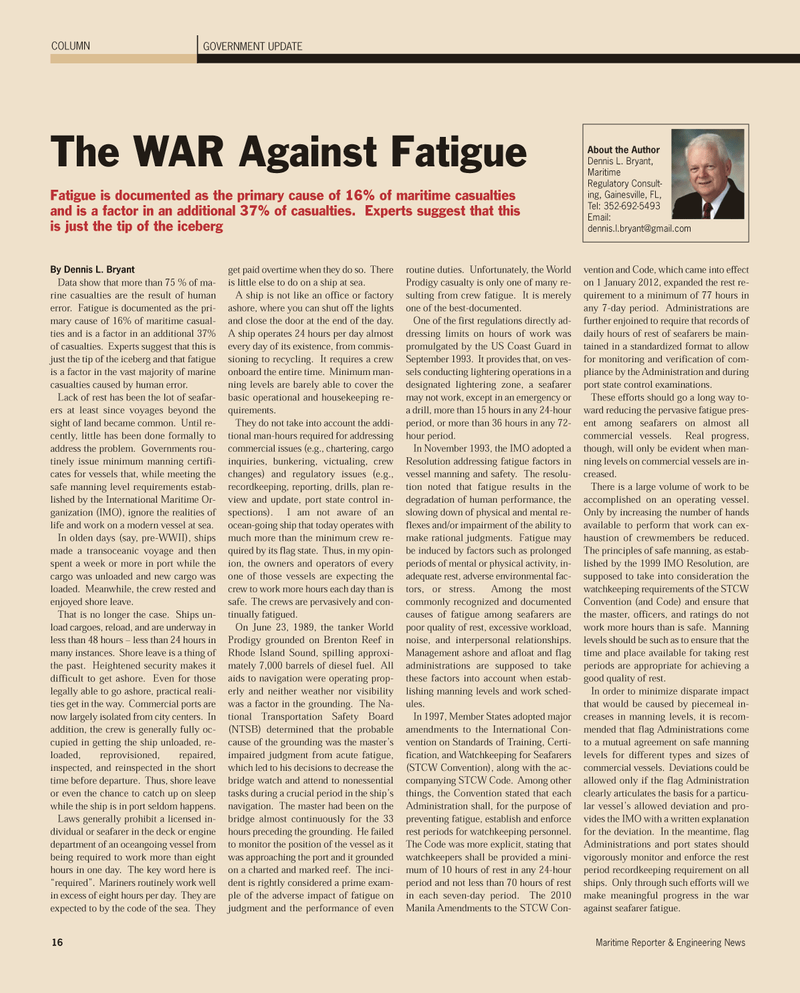
Page 16: of Maritime Reporter Magazine (February 2012)
Cruise Shipping Annual
Read this page in Pdf, Flash or Html5 edition of February 2012 Maritime Reporter Magazine
By Dennis L. BryantData show that more than 75 % of ma- rine casualties are the result of humanerror. Fatigue is documented as the pri- mary cause of 16% of maritime casual-ties and is a factor in an additional 37% of casualties. Experts suggest that this isjust the tip of the iceberg and that fatigue is a factor in the vast majority of marine casualties caused by human error. Lack of rest has been the lot of seafar- ers at least since voyages beyond the sight of land became common. Until re-cently, little has been done formally to address the problem. Governments rou- tinely issue minimum manning certifi- cates for vessels that, while meeting the safe manning level requirements estab- lished by the International Maritime Or- ganization (IMO), ignore the realities of life and work on a modern vessel at sea. In olden days (say, pre-WWII), ships made a transoceanic voyage and then spent a week or more in port while thecargo was unloaded and new cargo was loaded. Meanwhile, the crew rested and enjoyed shore leave. That is no longer the case. Ships un-load cargoes, reload, and are underway in less than 48 hours ? less than 24 hours inmany instances. Shore leave is a thing of the past. Heightened security makes it difficult to get ashore. Even for those legally able to go ashore, practical reali- ties get in the way. Commercial ports are now largely isolated from city centers. In addition, the crew is generally fully oc- cupied in getting the ship unloaded, re-loaded, reprovisioned, repaired, inspected, and reinspected in the shorttime before departure. Thus, shore leave or even the chance to catch up on sleep while the ship is in port seldom happens.Laws generally prohibit a licensed in- dividual or seafarer in the deck or engine department of an oceangoing vessel from being required to work more than eight hours in one day. The key word here is ?required?. Mariners routinely work well in excess of eight hours per day. They are expected to by the code of the sea. They get paid overtime when they do so. There is little else to do on a ship at sea.A ship is not like an office or factory ashore, where you can shut off the lights and close the door at the end of the day. A ship operates 24 hours per day almostevery day of its existence, from commis- sioning to recycling. It requires a crew onboard the entire time. Minimum man-ning levels are barely able to cover the basic operational and housekeeping re- quirements. They do not take into account the addi- tional man-hours required for addressingcommercial issues (e.g., chartering, cargo inquiries, bunkering, victualing, crew changes) and regulatory issues (e.g., recordkeeping, reporting, drills, plan re- view and update, port state control in- spections). I am not aware of an ocean-going ship that today operates withmuch more than the minimum crew re- quired by its flag state. Thus, in my opin- ion, the owners and operators of every one of those vessels are expecting the crew to work more hours each day than is safe. The crews are pervasively and con- tinually fatigued. On June 23, 1989, the tanker World Prodigy grounded on Brenton Reef inRhode Island Sound, spilling approxi-mately 7,000 barrels of diesel fuel. All aids to navigation were operating prop- erly and neither weather nor visibilitywas a factor in the grounding. The Na- tional Transportation Safety Board (NTSB) determined that the probablecause of the grounding was the master?s impaired judgment from acute fatigue, which led to his decisions to decrease thebridge watch and attend to nonessential tasks during a crucial period in the ship?s navigation. The master had been on the bridge almost continuously for the 33hours preceding the grounding. He failed to monitor the position of the vessel as it was approaching the port and it grounded on a charted and marked reef. The inci- dent is rightly considered a prime exam- ple of the adverse impact of fatigue on judgment and the performance of even routine duties. Unfortunately, the World Prodigy casualty is only one of many re- sulting from crew fatigue. It is merely one of the best-documented.One of the first regulations directly ad- dressing limits on hours of work was promulgated by the US Coast Guard in September 1993. It provides that, on ves- sels conducting lightering operations in adesignated lightering zone, a seafarer may not work, except in an emergency or a drill, more than 15 hours in any 24-hour period, or more than 36 hours in any 72- hour period. In November 1993, the IMO adopted a Resolution addressing fatigue factors in vessel manning and safety. The resolu- tion noted that fatigue results in the degradation of human performance, the slowing down of physical and mental re- flexes and/or impairment of the ability to make rational judgments. Fatigue may be induced by factors such as prolonged periods of mental or physical activity, in- adequate rest, adverse environmental fac- tors, or stress. Among the most commonly recognized and documentedcauses of fatigue among seafarers are poor quality of rest, excessive workload, noise, and interpersonal relationships.Management ashore and afloat and flagadministrations are supposed to take these factors into account when estab- lishing manning levels and work sched- ules.In 1997, Member States adopted majoramendments to the International Con-vention on Standards of Training, Certi- fication, and Watchkeeping for Seafarers (STCW Convention), along with the ac- companying STCW Code. Among other things, the Convention stated that each Administration shall, for the purpose ofpreventing fatigue, establish and enforce rest periods for watchkeeping personnel. The Code was more explicit, stating that watchkeepers shall be provided a mini- mum of 10 hours of rest in any 24-hour period and not less than 70 hours of restin each seven-day period. The 2010 Manila Amendments to the STCW Con- vention and Code, which came into effect on 1 January 2012, expanded the rest re- quirement to a minimum of 77 hours inany 7-day period. Administrations are further enjoined to require that records ofdaily hours of rest of seafarers be main- tained in a standardized format to allow for monitoring and verification of com- pliance by the Administration and during port state control examinations. These efforts should go a long way to- ward reducing the pervasive fatigue pres- ent among seafarers on almost all commercial vessels. Real progress, though, will only be evident when man- ning levels on commercial vessels are in- creased. There is a large volume of work to be accomplished on an operating vessel. Only by increasing the number of handsavailable to perform that work can ex- haustion of crewmembers be reduced. The principles of safe manning, as estab-lished by the 1999 IMO Resolution, aresupposed to take into consideration the watchkeeping requirements of the STCW Convention (and Code) and ensure that the master, officers, and ratings do not work more hours than is safe. Manning levels should be such as to ensure that the time and place available for taking rest periods are appropriate for achieving a good quality of rest. In order to minimize disparate impactthat would be caused by piecemeal in- creases in manning levels, it is recom- mended that flag Administrations come to a mutual agreement on safe manninglevels for different types and sizes of commercial vessels. Deviations could be allowed only if the flag Administration clearly articulates the basis for a particu- lar vessel?s allowed deviation and pro- vides the IMO with a written explanation for the deviation. In the meantime, flag Administrations and port states shouldvigorously monitor and enforce the restperiod recordkeeping requirement on all ships. Only through such efforts will we make meaningful progress in the war against seafarer fatigue. COLUMNGOVERNMENT UPDATE 16Maritime Reporter & Engineering News The WAR Against Fatigue About the AuthorDennis L. Bryant,Maritime Regulatory Consult-ing, Gainesville, FL,Tel: 352-692-5493 Email:[email protected] is documented as the primary cause of 16% of maritime casualties and is a factor in an additional 37% of casualties. Experts suggest that this is just the tip of the iceberg MR Feb.12 # 2 (10-17):MR Template 2/6/2012 12:21 PM Page 16

 15
15

 17
17
